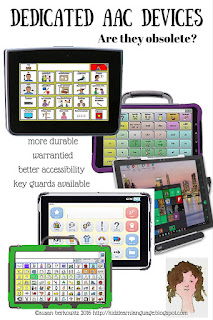With seemingly everyone using iPads with AAC apps these days, you might think there aren’t any dedicated SGD (speech generating devices) still around, nor any good reasons to pay (or have your insurance pay) $5,000 to $9,000 (or more) for one.
But both assumptions would be a mistake. Despite the many changes and downturns in the industry, there are still some AAC device manufacturers out there alive and kicking. And there are some excellent reasons for using one of them; rather than the ubiquitous iPads.
1. Saltillo is the maker of the Nova Chat range of devices; with 5”, 8”, 10”, and 12” screen sizes, as well as the Fusion models with head pointing and advanced scanning options for alternate access.
Many users - as well as school districts - use the app version of the software (Touch Chat) on iPads rather than purchasing dedicated devices.
But iPads don’t come with the company’s 3 year warranty.
2. Prentke-Romich Co. (PRC) continues to make their specialized dedicated devices with Semantic Compaction language system and use of core words. I love to recommend PRC devices to young children who haven’t had a ton of exposure to other symbol systems yet, and who appear to have a good support system.
PRC devices use a closed set of Unity symbols, feature syntactic prediction and use limited navigation. Unity uses a relatively small symbol set, representing core words, that can be combined endlessly into genuine messages, in the natural way we all speak.
Core words are on the front page and easily accessible. They never move, or are found in different locations on other pages. Unity symbol placement allows for learning based on motor patterns. There are also symbols and spaces for fringe vocabulary.
Their Accent devices come with 8, 10, or 14” screens.
They, too, have an app: LAMP Words for Life, that offers their 84-location page set. with hide-able buttons.
3. Tobii-Dynavox continues to product some of both the Tobii and Dynavox line of products, while having eliminated some since Tobii bought out Dynavox. Toby now has a line of tablet-based devices with 7, 10, 15, and 8” screens. They also have a line of eye-gaze technologies from integrated eye gaze systems to portable units that can be added to standard PCs.
Tobii's Sono Flex and Dynavox's Compass apps are also available for the iPad.
I see a fair number of students whose physical disabilities are significant enough to require use of eye gaze for communication. I push use of partner assisted scanning (PAS) as a back-up strategy or mode, since eye gaze use is fatiguing, and it takes a while to become proficient.
I have a preference for the Tobii and PRC systems; based mostly on the numbers of clients I see who calibrate more consistently or easily with one of these two systems as opposed to others.
Bonus 4: Zygo also continues to produce dedicated devices and uses the highly developed Grid software for AAC. heir Grid Pad line comes in 8, 10, 11, 13, ad 18” screens. It is also available with an eye gaze unit which, I confess, I have not tried.
It is important to note that the android tablets upon which most of these devices are based have less “finicky” touch screens than iOS devices, making them a better choice for students who have difficulty with activating the iPad screen. For those students with fine motor difficulties who need key guards, there are key guards that snap onto them and stay secure.
There are some other devices available in the marketplace. Because most of the clients I see go through their insurance for purchase of a dedicated device, I tend to only work with those companies whose devices can be paid for through medical insurance. That has always ruled out some smaller companies that don’t have funding departments and aren’t approved by Medicaid (here, in my case that’s Medi- Cal).
So, while this list is hardly exhausting, or even detailed about those devices I do list, I hope I’ve opened some of your eyes to iPad alternatives, and to the reasons why we still use dedicated devices in AAC.
I can’t stress enough the need for a comprehensive AAC evaluation to determine the most appropriate device and/or system for your student. Often iPads that are dedicated to AAC (have no other apps on them and are not used for education or leisure) are perfectly fine AAC solutions. However, that is not always the case, and providing only iPads without considering those factors can be dangerous.
So, keep on talking - no matter what kind of voice you have!




No comments
Post a Comment